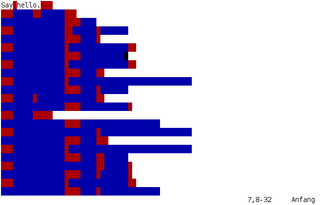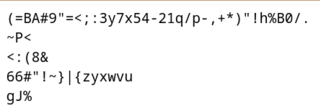Brainfuck is an esoteric programming language created in 1993 by Urban Müller.
C is a general-purpose computer programming language. It was created in the 1970s by Dennis Ritchie, and remains very widely used and influential. By design, C's features cleanly reflect the capabilities of the targeted CPUs. It has found lasting use in operating systems, device drivers, and protocol stacks, but its use in application software has been decreasing. C is commonly used on computer architectures that range from the largest supercomputers to the smallest microcontrollers and embedded systems.
Forth is a procedural, stack-oriented programming language and interactive environment designed by Charles H. "Chuck" Moore and first used by other programmers in 1970. Although not an acronym, the language's name in its early years was often spelled in all capital letters as FORTH. The FORTH-79 and FORTH-83 implementations, which were not written by Moore, became de facto standards, and an official standardization of the language was published in 1994 as ANS Forth. A wide range of Forth derivatives existed before and after ANS Forth. The free software Gforth implementation is actively maintained, as are several commercially supported systems.
A "Hello, World!" program is generally a simple computer program which outputs to the screen a message similar to "Hello, World!" while ignoring any user input. A small piece of code in most general-purpose programming languages, this program is used to illustrate a language's basic syntax. A "Hello, World!" program is often the first written by a student of a new programming language, but such a program can also be used as a sanity check to ensure that the computer software intended to compile or run source code is correctly installed, and that its operator understands how to use it.

The Compiler Language With No Pronounceable Acronym (INTERCAL) is an esoteric programming language that was created as a parody by Don Woods and James M. Lyon, two Princeton University students, in 1972. It satirizes aspects of the various programming languages at the time, as well as the proliferation of proposed language constructs and notations in the 1960s.

A programming language is a system of notation for writing computer programs.
In computing, a segmentation fault or access violation is a fault, or failure condition, raised by hardware with memory protection, notifying an operating system (OS) the software has attempted to access a restricted area of memory. On standard x86 computers, this is a form of general protection fault. The operating system kernel will, in response, usually perform some corrective action, generally passing the fault on to the offending process by sending the process a signal. Processes can in some cases install a custom signal handler, allowing them to recover on their own, but otherwise the OS default signal handler is used, generally causing abnormal termination of the process, and sometimes a core dump.
An esoteric programming language is a programming language designed to test the boundaries of computer programming language design, as a proof of concept, as software art, as a hacking interface to another language, or as a joke. The use of the word esoteric distinguishes them from languages that working developers use to write software. The creators of most esolangs do not intend them to be used for mainstream programming, although some esoteric features, such as visuospatial syntax, have inspired practical applications in the arts. Such languages are often popular among hackers and hobbyists.

In computer science, an interpreter is a computer program that directly executes instructions written in a programming or scripting language, without requiring them previously to have been compiled into a machine language program. An interpreter generally uses one of the following strategies for program execution:
- Parse the source code and perform its behavior directly;
- Translate source code into some efficient intermediate representation or object code and immediately execute that;
- Explicitly execute stored precompiled bytecode made by a compiler and matched with the interpreter Virtual Machine.
In computer science, an abstract machine is a theoretical model that allows for a detailed and precise analysis of how a computer system functions. It is similar to a mathematical function in that it receives inputs and produces outputs based on predefined rules. Abstract machines vary from literal machines in that they are expected to perform correctly and independently of hardware. Abstract machines are "machines" because they allow step-by-step execution of programmes; they are "abstract" because they ignore many aspects of actual (hardware) machines. A typical abstract machine consists of a definition in terms of input, output, and the set of allowable operations used to turn the former into the latter. They can be used for purely theoretical reasons as well as models for real-world computer systems. In the theory of computation, abstract machines are often used in thought experiments regarding computability or to analyse the complexity of algorithms. This use of abstract machines is fundamental to the field of computational complexity theory, such as finite state machines, Mealy machines, push-down automata, and Turing machines.
In computer science, imperative programming is a programming paradigm of software that uses statements that change a program's state. In much the same way that the imperative mood in natural languages expresses commands, an imperative program consists of commands for the computer to perform. Imperative programming focuses on describing how a program operates step by step, rather than on high-level descriptions of its expected results.

Whitespace is an esoteric programming language developed by Edwin Brady and Chris Morris at the University of Durham. It was released on 1 April 2003. Its name is a reference to whitespace characters. Unlike most programming languages, which ignore or assign little meaning to most whitespace characters, the Whitespace interpreter ignores any non-whitespace characters. Only spaces, tabs and linefeeds have meaning.
x86 assembly language is the name for the family of assembly languages which provide some level of backward compatibility with CPUs back to the Intel 8008 microprocessor, which was launched in April 1972. It is used to produce object code for the x86 class of processors.

Malbolge is a public domain esoteric programming language invented by Ben Olmstead in 1998, named after the eighth circle of hell in Dante's Inferno, the Malebolge. It was specifically designed to be almost impossible to use, via a counter-intuitive 'crazy operation', base-three arithmetic, and self-altering code. It builds on the difficulty of earlier challenging esoteric languages, but exaggerates this aspect to an extreme degree, playing on the entangled histories of computer science and encryption. Despite this design, it is possible to write useful Malbolge programs.
In computer science, computer engineering and programming language implementations, a stack machine is a computer processor or a virtual machine in which the primary interaction is moving short-lived temporary values to and from a push down stack. In the case of a hardware processor, a hardware stack is used. The use of a stack significantly reduces the required number of processor registers. Stack machines extend push-down automata with additional load/store operations or multiple stacks and hence are Turing-complete.
In computer science, a calling convention is an implementation-level (low-level) scheme for how subroutines or functions receive parameters from their caller and how they return a result. When some code calls a function, design choices have been taken for where and how parameters are passed to that function, and where and how results are returned from that function, with these transfers typically done via certain registers or within a stack frame on the call stack. There are design choices for how the tasks of preparing for a function call and restoring the environment after the function has completed are divided between the caller and the callee. Some calling convention specifies the way every function should get called. The correct calling convention should be used for every function call, to allow the correct and reliable execution of the whole program using these functions.
IP Pascal is an implementation of the Pascal programming language using the IP portability platform, a multiple machine, operating system and language implementation system. It implements the language "Pascaline", and has passed the Pascal Validation Suite.

Control tables are tables that control the control flow or play a major part in program control. There are no rigid rules about the structure or content of a control table—its qualifying attribute is its ability to direct control flow in some way through "execution" by a processor or interpreter. The design of such tables is sometimes referred to as table-driven design. In some cases, control tables can be specific implementations of finite-state-machine-based automata-based programming. If there are several hierarchical levels of control table they may behave in a manner equivalent to UML state machines
In computer programming, a function or subroutine is a sequence of program instructions that performs a specific task, packaged as a unit. This unit can then be used in programs wherever that particular task should be performed.
Leet is an esoteric programming language based loosely on Brainfuck and named for the resemblance of its source code to the symbolic language "L33t 5p34k". L33t was designed by Stephen McGreal and Alex Mole to be as confusing as possible. It is Turing-complete and has the possibility for self-modifying code. Software written in the language can make network connections and may therefore be used to write malware.





